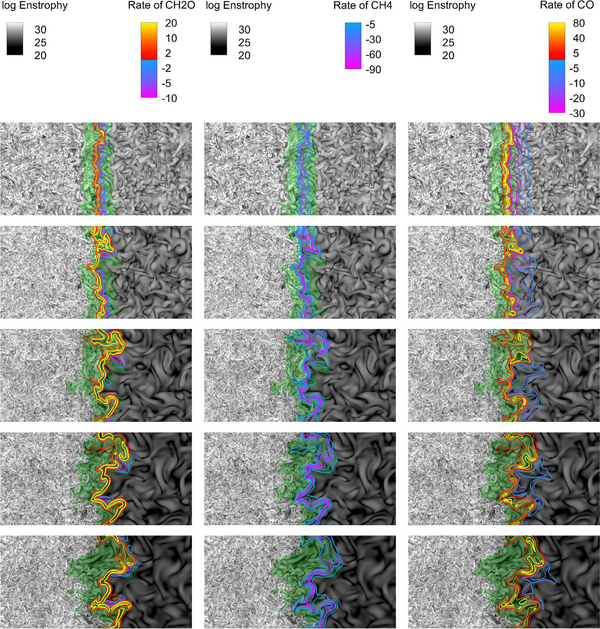DNS of high Karlovitz number turbulent premixed flames
Project participants: F. Pignatelli, H. Carlsson, T. Nilsson, R. Yu & X.S. Bai
Background
Premixed flames under the conditions of high intensity and small length scale turbulence, typically at high Karlovitz numbers, Ka, are commonly used in engineering combustion devices, e.g., in gas turbines and internal combustion engines. The structures of flames under these conditions are however less well understood. The thin reaction zones regime, where turbulence micro-scales are small enough to penetrate and perturb the preheat layer of the flame but not the reaction layer, is considered to occur for 1 < Ka ≲ 100. At Ka well above 100 it is expected that turbulence micro-scales can penetrate also the reaction zone leading to distributed or broken reaction zones.
Goal of this research project
The goal of this project is to improve the understanding of the reaction zone structures and the mechanisms of flame propagation under high Ka conditions. The focus is on the interaction between the sub-layers of turbulent premixed flames and small-scale turbulence, a process that is difficult to investigate experimentally.
Recent results
Lean premixed turbulent methane-air flames have been investigated using direct numerical simulations (DNS) for different Karlovitz numbers (Ka), ranging from 65 to 3350. The flames are imposed to a high intensity small scale turbulent environment, corresponding to high Ka conditions, and the effect on the flame structure is investigated during the transition from initial laminar flame to highly distorted turbulent flame. The focus is on the internal structure of different sub-layers of these flames. The preheat layer, fuel consumption layer and oxidation layer are characterized by the distribution of formaldehyde, the fuel consumption rate and the CO consumption rate, respectively. Different measures that quantify sub-layer thickness for turbulent flames have been defined and analyzed. The flame brush is broadened with time while the local thickness (excluding large scale wrinkling) of all three layers initially show thinning due to the interaction of the flame with the turbulent flow field. As time passes, the local thickness of the preheat layer and fuel consumption layer are restored while the oxidation layer remains thinned due to suppression of CO consuming reactions. As Ka increases there is an increasing probability of finding thinned, large gradient regions in each of these sub-layers, see Fig.1. The contribution to the evolution of flame thickness from normal strain rate, chemical reaction and normal and tangential diffusion is analyzed in terms of a gradient transport equation. The relative size of the terms changes as Ka increase and, in particular, the term due to chemical reactions loses its relative significance. The observed thinning of the local flame structure is attributed to the preferential alignment of the flame normal with the compressive strain rate eigenvectors. Such alignment provides a mechanism for the flame thinning, consistent with the behavior of non-reacting scalars. A preferred angle of about 20 degrees is observed between the flame normal and the compressive strain rate eigenvector.

Sample publications
- H Carlsson, R Yu, XS Bai, Direct numerical simulation of lean premixed CH 4/air and H2/air flames at high Karlovitz numbers, Int. Journal of Hydrogen Energy, 39 (2014) 20216-20232.
- H. Carlsson, R. X. Yu, and X. S. Bai, "Flame structure analysis for categorization of lean premixed CH4/air and H2/air flames at high Karlovitz numbers: Direct numerical simulation studies," Proceedings of the Combustion Institute 35, 1425-1432 (2015).
- T. Nilsson, H. Carlsson, R. Yu, X.S. Bai, Structures of turbulent premixed flames in the high Karlovitz number regime - DNS analysis, Fuel 216 (2018) 627-638.
- T Nilsson, I Langella, NAK Doan, N Swaminathan, R Yu, XS Bai, A priori analysis of sub-grid variance of a reactive scalar using DNS data of high Ka flames, Combustion Theory and Modelling, 2019, in press.
- T Nilsson, R Yu, NAK Doan, I Langella, N Swaminathan, XS Bai, Filtered Reaction Rate Modelling in Moderate and High Karlovitz Number Flames: an a Priori Analysis, Flow, Turbulence and Combustion, 2019, in press.
- R Yu, T Nillson, XS Bai, AN Lipatnikov, Evolution of averaged local premixed flame thickness in a turbulent flow, Combustion and Flame 207 (2019) 232-249.
